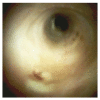Successful endoscopic treatment of an intraductal papillary neoplasm of the bile duct
- PMID: 28572878
- PMCID: PMC5437390
- DOI: 10.4253/wjge.v9.i5.238
Successful endoscopic treatment of an intraductal papillary neoplasm of the bile duct
Abstract
We present a case of a 76-year-old man with right upper quadrant abdominal pain and weight loss, who was found to have an intraductal papillary neoplasm of the bile duct (IPNB) of the pancreaticobiliary subtype, deemed curatively resectable. The patient declined surgery and opted for endoscopic therapy. He underwent two sessions of endoscopic retrograde cholangiopancreatography (ERCP)-guided radiofrequency ablation (RFA). Ten months later, no evidence of recurrence was identified on repeat ERCP. To our knowledge, this is the first reported case of successful use of RFA as a primary treatment modality for resectable IPNB.
Keywords: Ablation technique; Advanced endoscopy; Bile duct neoplasms; Common bile duct diseases; Extrahepatic bile duct.
Conflict of interest statement
Conflict-of-interest statement: The authors report no financial or other conflicts of interest (including but not limited to commercial, personal, political, intellectual, or religious interests).
Figures






References
-
- Rocha FG, Lee H, Katabi N, DeMatteo RP, Fong Y, D’Angelica MI, Allen PJ, Klimstra DS, Jarnagin WR. Intraductal papillary neoplasm of the bile duct: a biliary equivalent to intraductal papillary mucinous neoplasm of the pancreas? Hepatology. 2012;56:1352–1360. - PubMed
-
- Sharaiha RZ, Natov N, Glockenberg KS, Widmer J, Gaidhane M, Kahaleh M. Comparison of metal stenting with radiofrequency ablation versus stenting alone for treating malignant biliary strictures: is there an added benefit? Dig Dis Sci. 2014;59:3099–3102. - PubMed
Publication types
LinkOut - more resources
Full Text Sources
Other Literature Sources

